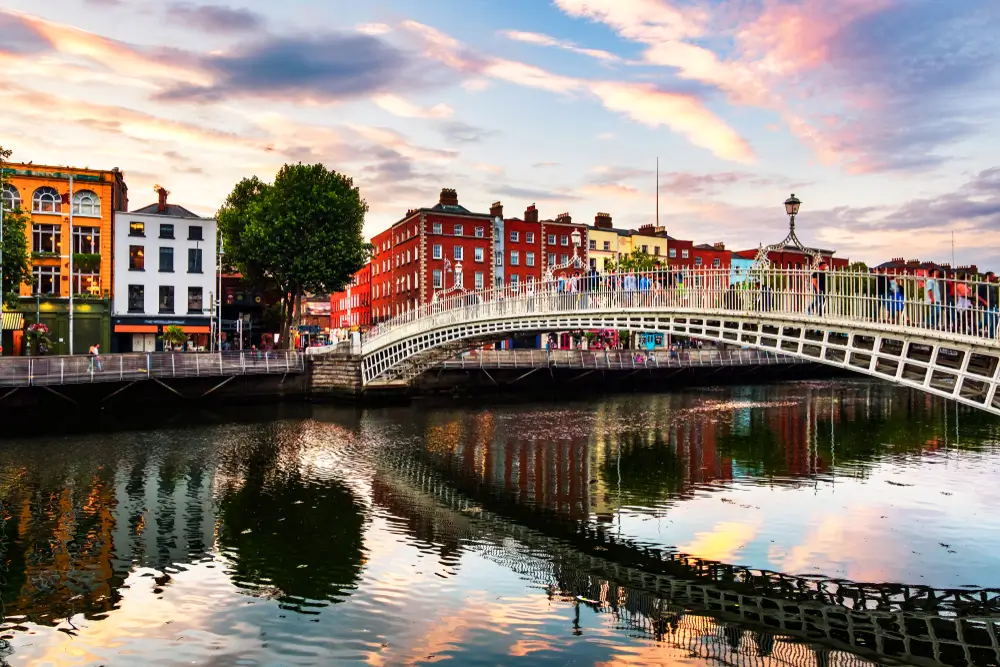Dublin
Dublin Travel Guide

With its lush green valleys, rich history, and vibrant culture, Dublin, the capital of Ireland, is a destination that every traveler dreams of. This unique city is full of historical traces, fascinating with its colorful streets, and offers a warm welcome with its friendly people. Dublin attracts attention with its culture. It offers you a piece of its history in every corner you visit. You should come to Dublin to follow in the footsteps of legendary writers James Joyce and Oscar Wilde, feel like a bookworm in the famous Trinity College Library, or find peace in the serenity of historic churches. However, Dublin attracts attention not only with its history but also with its magnificent nature and warm culture. You will live every moment to the fullest in this city with its colorful pubs and friendly locals who will steal your heart with traditional Irish music and dance.
Where is Dublin?
Dublin is situated on a bay at the mouth of the River Liffey in the province of Leinster on the European continent. Also, It is the capital and largest city of Ireland with a population of approximately 1.4 million population. Most of the population is in the Greater Dublin Area living with a blend of historic landmarks, modern architecture, and lively neighborhoods, making it a dynamic and exciting destination to explore.
Where To Stay In Dublin?
Dublin offers a diverse range of accommodation options catering to various preferences and budgets. Whether you are looking for budget-friendly hotels in Dublin or affordable luxury accommodations, you can easily find them. You may have a hard time deciding where to stay while wandering around the streets of Dublin. That's why we are here to give you some recommendations about accommodations in Dublin:
- City Center: The bustling heart of Dublin, offering proximity to landmarks such as Trinity College, Dublin Castle, and Temple Bar. Accommodations range from budget-friendly hotels to luxury options.
- Temple Bar: Known for its vibrant nightlife, cultural venues, and colorful pubs. It's a lively area with a variety of accommodations, ranging from trendy hostels to boutique hotels.
- Merrion Square/St. Stephen's Green: These neighborhoods offer a blend of historic charm and modern amenities. Close to attractions such as the National Gallery of Ireland and a variety of dining options.
- Ballsbridge/Donnybrook: These neighborhoods are residential areas located south of the city center. They feature upscale restaurants and scenic views along the Grand Canal, which are ideal for those seeking a peaceful stay within easy reach of attractions.
- Smithfield: Smithfield offers historic charm alongside contemporary flair. Dublin is home to attractions such as the Old Jameson Distillery, as well as a variety of dining and entertainment options.
Find all the best hotels in Dublin here!
Places To Visit In Dublin
As soon as you step into the streets of Dublin, you will lose yourself in the gem of Ireland. There are numerous captivating places for travelers to visit in Dublin, which will mesmerize you with its rich history, culture, and beautiful nature. Here are some of the best attractions to visit in Dublin:
- Guinness Storehouse: Discover the history of Ireland's most renowned beer at this iconic brewery. Enjoy panoramic views of Dublin from the Gravity Bar.
- St. Patrick's Cathedral: Admire the grandeur of Ireland's largest cathedral, founded in 1191. Mesmerize yourself with the beautiful interior of the cathedral, which showcases medieval tombs, stunning stained glass windows, and serene gardens.
- The Book of Kells and Trinity College: Explore Ireland's oldest university, Trinity College, and marvel at the beautifully illuminated manuscript, the Book of Kells, housed in the historic library.
- Dublin Castle: Explore centuries of history at Dublin Castle, from its medieval beginnings to its function as a government complex. Don't miss the stunning State Apartments and the Gothic Chapel Royal.
- Kilmainham Gaol: Get ready to be shocked; the jail is the largest unoccupied prison in Europe and holds countless tales within its thick, cold walls. It is also an important symbol of Ireland's independence.
- City Parks: Cherished and adored, the city's green spaces include the hidden oasis of Iveagh Gardens, Phoenix Park, St. Stephen's Green, and Merrion Square.
- The Hop-on Hop-off Bus Tour: Thanks to this bus tour, you do not need a car to visit some of the best attractions in Dublin, such as St. Patrick's Cathedral, Ha'penny Bridge, Temple Bar, and the Guinness Storehouse. You can purchase a 24-hour or 48-hour ticket, which will cost you around 30 euros.
- Dublinia: Explore Dublin's Viking past and journey back in time to the medieval period of the city here. You can explore an amazing Viking battleship and get to know fierce Viking warriors.
- Dublin Beaches: If you are looking for hidden swimming spots with sandy beaches in Dublin, Dollymount Strand and Sandycove Beach can be good choices for you.
Is Dublin Safe?
Dublin is generally considered a safe city for both residents and visitors. However, like any metropolitan area, it has its share of crime and safety concerns. Due to its dense population, Dublin has higher crime rates compared to other regions in Ireland. However, Dublin is still a safe city for tourists. The city does not experience a lot of crime, making it an attractive vacation destination for everyone.
Is Dublin Expensive To Visit?
Dublin is known to be one of the more expensive cities in Europe, with average daily costs ranging from €80 to €225 per person, depending on your budget and spending habits. However, by making smart choices in accommodation, dining, and activities you can do an affordable stay for your budget in Dublin and enjoy your trip.
Dublin Currency
The currency used in Dublin, Ireland is the Euro (€). Irish consumers prefer to use digital payment methods such as credit and debit cards, digital wallets, and direct debit over cash. However, it is advisable to carry some cash, especially for smaller purchases, tipping, or in case you encounter a situation where card payment isn't available.
Dublin Language
In Dublin, there are two official languages in Ireland: English and Irish. English is the predominant language spoken in Dublin. Approximately 90% of Irish people speak English natively in Dublin. It is primarily used for day-to-day communication, business, and education.
Dublin Time Zone
Dublin is located in the Greenwich Mean Time (GMT) zone during standard time, and it observes daylight saving time, shifting to Irish Standard Time (IST) during the summer months. Therefore, the time zone in Dublin can be either GMT or IST, depending on the time of year:
- During standard time (late October to late March), Dublin follows Greenwich Mean Time (GMT), which is Coordinated Universal Time (UTC) +0.
- During daylight saving time (late March to late October), Dublin switches to Irish Standard Time (IST), which is UTC +1.
How Many Days To Visit Dublin?
if your schedule is tight and you're looking for a quick experience, 2 to 3 days will also be enough to enjoy Dublin. However, if you prefer a relaxed Dublin visit, take your time and stay for at least 4 to 7 days.
When Is The Best Time To Stay In Dublin?
The best time to visit Dublin, Ireland is from June to August, when the weather is pleasant and there are many festivals to enjoy. However, it also depends on your preferences and what you aim to experience during your stay. Here’s the breakdown of seasons in Dublin:
- Summer (June to August): Summer is the peak season for tourists in Dublin, with longer days and warmer weather. During the summer, festivals fill the streets, making it the best time for outdoor activities. You can witness and participate in these charming festivals, enjoy the beautiful hidden swimming spots, and experience amazing nature. However, visitors should be aware that this is the most expensive time to visit Dublin.
- Spring and Autumn (March - May, September - October): With mild weather and fewer crowds compared to summer, these seasons are a good choice for budget-conscious travelers. The city comes alive with events such as St. Patrick's Day celebrations in March. You can enjoy cultural events such as the Dublin Theatre Festival and the Dublin Fringe Festival in autumn.
- Winter (December - February): Winter is the quietest time to visit Dublin, with fewer tourists and lower prices on accommodations. However, it is still enchanting with Christmas spirit and local holiday markets.
What To Pack For Your Visit To Dublin?
When preparing for your trip to Dublin, be mindful of packing according to the season and planned activities. Here’s the short packing list for Dublin:
- For the summer, go for light, breathable clothing, swimwear, sunscreen, and comfortable walking shoes, along with sun protection gear.
- For winter visits, bring a warm winter coat and some rain gear for chilly temperatures, gloves, scarf, hat, and indoor clothing.
- For spring visits, pack some sweaters along with your T-shirts for warmer temperatures, a light jacket, and versatile footwear.
- For fall visits, bring jackets, sweaters, and scarves for mild temperatures, a scarf, a sweater, and comfortable walking shoes.
Dublin Food
When visiting Ireland, your palate will be delighted by a diverse culinary scene offering a variety of traditional and modern dishes. Here is a list of the best Dublin foods you should try during your trip:
- Irish Stew: A comforting dish with tender lamb or beef, potatoes, carrots, and onions simmered in a rich Guinness-flavored broth.
- Fish and Chips: Crispy battered fish served with golden fries, mushy peas, and tartar sauce – a classic favorite.
- Boxty: Traditional Irish potato pancake made with grated potatoes, flour, and buttermilk, perfect as a side or filled with savory ingredients.
- Coddle: A hearty Dublin stew with sausages, bacon, onions, and potatoes simmered in flavorful broth.
- Dublin Bay Prawns: Sweet and delicate langoustines, grilled, boiled, or pan-fried and served with garlic butter and crusty bread.
- Irish Breakfast: A hearty morning meal featuring eggs, bacon, sausage, black and white pudding, grilled tomatoes, mushrooms, and toast.
- Guinness Beef Pie: Tender beef stewed in rich Guinness gravy, topped with flaky pastry and baked until golden and bubbling.
- Dublin Bay Oysters: Fresh oysters harvested from nearby coastlines, served raw with lemon or dressed with mignonette sauce.
Dublin Nightlife
When we mention Dublin nightlife, everyone first thinks about Irish pubs, obviously. Irish people adore having fun and enjoy socializing over a pint of beer. However, in Dublin, nightlife is not limited to just Irish pubs. There are also many trendy cocktail bars and lively nightclubs. Dublin's nightlife is vibrant and diverse, offering something for everyone. Here are some of the best nightlife spots in Dublin:
- The Temple Bar: This iconic area in Dublin is famous for its lively atmosphere, traditional pubs, and vibrant nightlife. It's a must-visit for those looking to experience the heart of Dublin's social scene.
- The George: Ireland's oldest gay bar, known for its vibrant atmosphere, drag shows, and themed nights, making it a popular nightlife destination. It's a welcoming space for everyone to enjoy a night out.
- Copper Face Jacks: Located on Harcourt Street, Copper Face Jacks is one of Dublin's most famous nightclubs, attracting a diverse crowd with its energetic music, lively dance floors, and late-night party vibe.
- Dicey's Garden: Situated at the Russell Court Hotel, Dicey's Garden is a popular outdoor venue with a spacious beer garden, live music, and DJs playing music late into the night. It's a favorite spot for locals and tourists alike, especially during the summer months.
- The Workman's Club: This trendy venue is located in Temple Bar and offers a diverse range of events, including live music, DJ sets, comedy shows, and club nights. It is a trendy and relaxed space with a cool ambiance and welcoming atmosphere.
- Whelan's: A Dublin institution, Whelan's is a renowned live music venue that has hosted performances by both local and international artists. From indie bands to acoustic acts, there's always something exciting happening at Whelan's.
- The Bernard Shaw: Known for its eclectic decor, creative events, and laid-back vibe, The Bernard Shaw is a popular spot for drinks, music, and good times. It's home to a vibrant beer garden, a pizza bus, and regular DJ sets.
- The Grand Social: This multi-purpose venue in the heart of Dublin that features live music, club nights, comedy shows, and more. With multiple bars, a beer garden, and a rooftop terrace, there's plenty to explore at The Grand Social.

